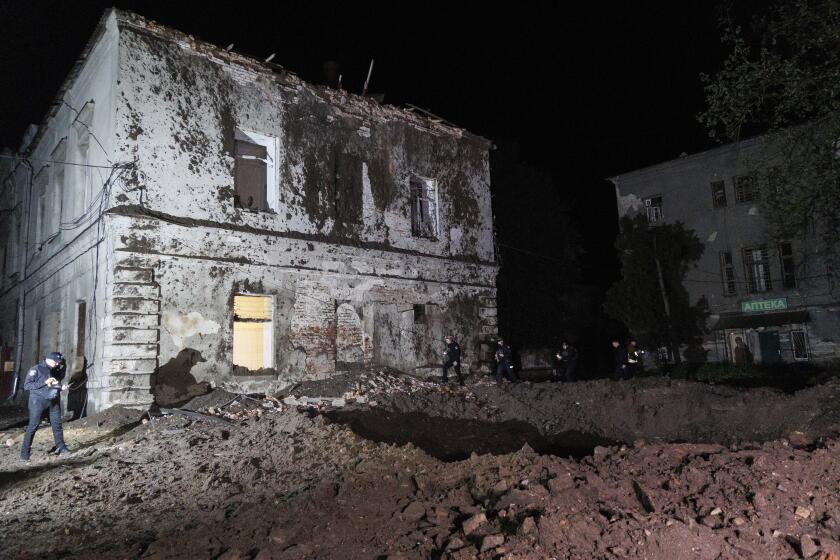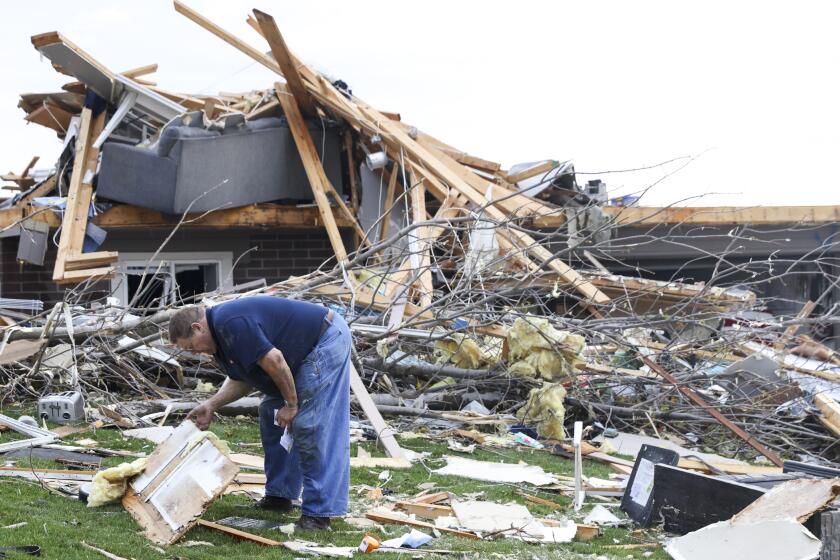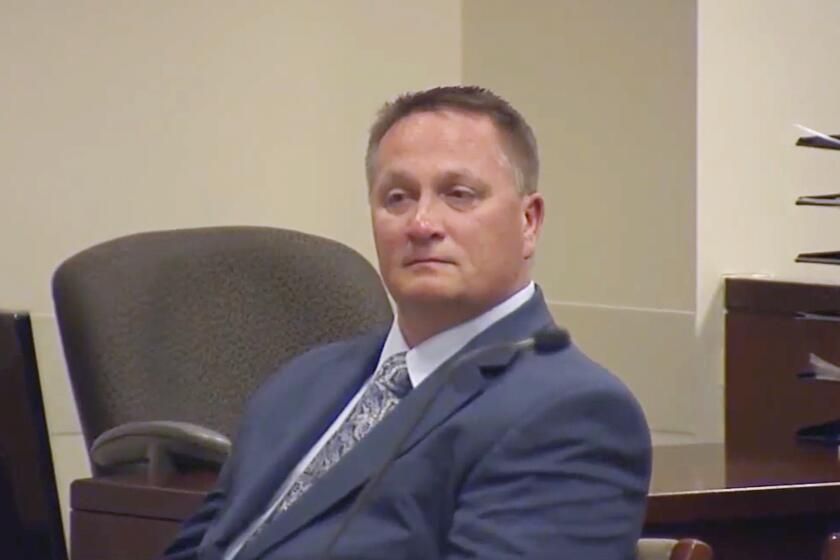Pledges of Help Grow Along With Problems
Governments and charities around the world pledged more than $120 million Tuesday to help victims of the southern Asian tsunami, but initial efforts to deliver the aid have been crippled by washed-out roads and bridges, civil war and the unprecedented scale of a disaster spread across thousands of miles.
Travelers said drives of 30 minutes had stretched into journeys of several hours because of the trail of destruction. Sri Lanka’s government and rebel-held areas refused to work together to help the victims, even issuing separate death tolls.
Aid officials struggled to answer calls to help millions of people left hungry and homeless in at least four countries.
“We have emergencies on four or five or six fronts, and each is a disaster in itself,” Jamie McGoldrick, an official with the U.N. Office for the Coordination of Humanitarian Affairs, said in Geneva. “We cannot cover all the fronts.”
After initial criticism by U.N. emergency coordinator Jan Egeland, who said that some of the world’s richest countries were being “stingy” with aid, the U.S. government increased its contribution and the White House insisted that the United States was doing its share.
The U.S. Agency for International Development more than doubled its pledge Tuesday, adding $20 million to an initial $15-million contribution.
Agency administrator Andrew S. Natsios said the U.S. would probably provide more for reconstruction of devastated areas, perhaps “hundreds of millions of dollars.”
The Navy dispatched the aircraft carrier Abraham Lincoln and a dozen other ships from the 7th Fleet to head to the stricken areas carrying food, water, blankets and emergency shelters.
“You name it, it’s on its way,” White House spokesman Trent Duffy said.
The ships will team up with about 10 of the Navy’s P3-Orion surveillance aircraft already scouring the ocean for survivors and bodies of those killed in the disaster, said Navy Cmdr. Ike Skelton of the 7th Fleet, based in Yokosuka, Japan. The vessels should begin arriving late today or sometime Thursday.
The White House said Tuesday that President Bush would have a regular briefing from National Security Council staff this morning and then make a brief statement on the disaster. Bush has stayed out of sight at his ranch in Crawford, Texas, with his aides issuing statements of condolence.
The 25-nation European Union and Japan each pledged $30 million.
Egeland praised the response Tuesday, backtracking from his earlier remarks.
“The international assistance has been immediate and generous,” Egeland said. “There are dozens of planes air-bound as we speak.”
Still, Egeland called the situation “one of the most devastating natural disasters” and potentially one of the costliest, estimating that billions of dollars would be needed to rebuild. He warned that a “second wave” of the disaster could be deadlier than the first, as millions of people risk disease from contaminated drinking water.
Natsios said that the aid package had drained USAID’s emergency relief fund, and it would have to ask the government for replenishments.
Relief officials are stunned by what they say is the unprecedented sweep of the destruction and the enormous amount of help needed. They say they are having to improvise and are struggling to coordinate myriad relief efforts among agencies, governments and private groups.
“This will be a massive effort, on all fronts,” McGoldrick said. “This is groundbreaking. It is taking on proportions that no one could ever imagine.”
The death toll is rising by the hour, and some remote areas remained out of reach, with untold devastation.
The priority within the next 72 hours, he said, is to get potable water and purification systems to survivors, as well as medicine and emergency shelter such as tents.
Agencies such as the U.N. are used to dealing with a couple of emergencies at a time, but nothing as widespread as the carnage in South Asia, McGoldrick said.
As devastated areas wait for international aid to arrive, volunteers are pulling together smaller, immediate relief efforts.
In Sri Lanka, a Canadian couple in Colombo organized an impromptu convoy to deliver food and medical supplies to the hard-hit town of Galle in the south.
Pamela and Jerry Porodo, two Canadians running a local property development company, said they offered their facilities, labor and fund-raising skills to the local Red Cross chapter, only to be blocked by bureaucracy.
So they joined dozens of volunteers who collected money, bought supplies and delivered them in a four-truck convoy themselves.
It took eight hours to struggle over 80 miles of washed-out roads, but their shipment was among the first to arrive.
Complaints about the slow pace of aid have been directed at governments, civic groups and international aid organizations.
“We’re hearing that a lot,” said Sithmini Perera, communication director with World Vision, a private aid agency with offices in Monrovia.
Perera said the scope of the disaster took aid workers by surprise. Furthermore, it happened during the holidays, when many staff members were not only off work but in some cases out of the country.
In the Maldives, a collection of islands in the Indian Ocean visited by thousands of scuba-diving tourists, 19 of 199 inhabited islands were still out of contact. Few are more than 6 feet above sea level, and the giant waves submerged them.
“We can’t tell if they have disappeared,” said Mohamed Latheef, the country’s ambassador to the U.N.
The aid efforts face political challenges too. In Indonesia and Sri Lanka, civil conflict is forcing governments to negotiate with rebels to deliver aid.
Indonesia’s Aceh province, near the quake’s epicenter, is one of the few areas to be hit by both the earthquake and the resulting tsunami, but access is difficult even in normal times because the government has been trying to put down an insurgency there for 28 years.
On Tuesday, the rebel Free Aceh Movement agreed to a cease-fire to allow the delivery of aid. The province’s death counts have risen steadily as government and international aid workers reach the area.
“We’re not going to arrest the rebels,” an Aceh police chief, Lt. Col. Ali Tarunajaya, told Associated Press. “They’re looking for members of their families, just like many of our police members are looking for theirs. We’re all crying together.”
In Sri Lanka, however, the disaster has hardened divisions. Government troops and the rebel Tamil Tigers, who have clashed since 1983 over the Tigers’ quest for a homeland, refused to cooperate against the crisis. The Tigers, who control a vast swath in Sri Lanka’s north and east, said aid had not reached them and they had been organizing their own relief efforts.
They have also issued separate death tolls, reporting as many as 2,000 people killed by the waves in Tiger territory. The government reports 6,000 dead in areas it controls.
The country’s survivors and aid workers face another hazardous legacy of the civil war: landmines unearthed by the waves.
“Mines were ... washed out of known minefields, so now we don’t know where they are,” Ted Chaiban, the Sri Lanka chief of UNICEF, said in a statement.
But some help began to arrive Tuesday, as 12 trucks carrying food left a U.N. warehouse in Colombo for the southern and eastern coasts.
A Red Cross plane with 105 tons of blankets, medicine and tarps for 50,000 landed Tuesday, and British aid agency Oxfam said a flight with 27 tons of water and sanitation equipment would arrive today.
In Somalia, the newly elected president lives in exile because of threats from rebels and is hard-pressed to direct any relief efforts in the African nation.
In the United States and around the world, people moved by the disaster offered donations by phone, the Internet and even through text messaging by cellphone. One charity, Mercy Corps, has raised a record $1 million so far, spokeswoman Nancy Lindborg said.
“Many people have connections to these countries. They have friends there and family there [and there is] the sheer human drama, the idea of walking on the beach and the next second having your entire life wiped away,” she said.
The U.S. Fund for UNICEF received $2 million in two days, spokeswoman Marissa Buckanoff said. “The generosity is unbelievable,” she said. “It might have to do with the timing. The disaster happened the day after Christmas and people are in a giving mood.”
That generosity must sustain the agencies when attention has subsided.
“In 10 days, after the rescue operations are over and the drama of what has happened has passed, that’s when the hard work really begins,” said Alfred Ironside, UNICEF’s spokesman.
*
(BEGIN TEXT OF INFOBOX)
Who’s giving
Donors around the world have pledged more than $120 million to help tsunami victims. Some of the figures:
AUSTRALIA: $7.6 million
AUSTRIA: $1.36 million
BRITAIN: $481,500 for sheets and tents sent to Sri Lanka. Giving $731,258 to EU aid effort and $100,000 to World Health Organization
CANADA: $814,300
CHINA: $2.6 million
CZECH REPUBLIC: $444,400
EUROPEAN UNION: $4 million
FINLAND: $781,200
FRANCE: $135,900
GERMANY: $2.72 million.Germany’s largest utility E.ON to donate $1.36 million
JAPAN: $30 million
KUWAIT: Supplies worth
$2 million pledged
NETHERLANDS: $2.72 million
SAUDI ARABIA: $20 million
SINGAPORE: $1.2 million
SPAIN: $1.36 million
SWEDEN: Swedish Red Cross to contribute $750,000
UNITED ARAB EMIRATES: $2 million
UNITED STATES: Pledged an initial $35 million
UNHCR: Initially distributing $380,000 of non-food relief items
UNICEF: Distributing clothing and 30,000 blankets and sleeping mats in Sri Lanka, 1,600 water tanks, 30,000 blankets, medical supplies and hundreds of thousands of water purification pills in India. Similar supplies heading to Indonesia and the Maldives
U.N. DEVELOPMENT PROGRAM: Provided $100,000 each to Sri Lanka, India, Indonesia, the Maldives and Thailand
U.N. POPULATION FUND: Earmarked up to $1 million and extra staff for health needs of pregnant and nursing women
Source: Reuters
**
Aid for quake and tsunami victims
These aid agencies are among those accepting contributions for assistance that they or their affiliates are providing for those affected by the earthquake and tsunami in Asia.
Air Serv International
6583 Merchant Place, Suite 100
Warrenton, VA 20187
(540) 428-2323
www.airserv.org
American Red Cross
International Response Fund
P.O. Box 37243
Washington, DC 20013
(800) HELP NOW
www.redcross.org
AmeriCares
88 Hamilton Ave.
Stamford, CT 06902
(800) 486-4357
www.americares.org
Baptist World Aid
Asia Tidal Waves
405 N. Washington St.
Falls Church, VA 22046
(703) 790-8980
www.bwanet.org/bwaid
B’nai B’rith International
Disaster Relief Fund
2020 K St. N.W. 7th Floor
Washington, DC 20006
(212) 490-3290
www.bnaibrith.org
Brother’s Brother Foundation
1200 Galveston Ave.
Pittsburgh, PA 15233
(412) 321-3160
www.brothersbrother.org
Christian Reformed World Relief Committee
South Asia Earthquake
2850 Kalamazoo Ave. S.E.
Grand Rapids, MI 49560-0001
(800) 55-CRWRC
www.crwrc.org
Food for the Hungry
Asia Quake Relief
1224 E. Washington St.
Phoenix, AZ 85034-1102
(800) 2-HUNGERS
www.fh.org
International Aid
17011 W. Hickory
Spring Lake, MI 49456
(800) 251-2502
www.internationalaid.org
International Medical Corps
1919 Santa Monica Blvd. Suite 300
Santa Monica, CA 90404
(800) 481-4462
www.imcworldwide.org
International Relief Teams
Asia Earthquake/Floods
3547 Camino del Rio S., Suite C
San Diego, CA 92108
(619) 284-7979
www.IRTeams.org
International Rescue Committee
P.O. Box 5058
Hagerstown, MD 21741-9874
(877) 733-8433
www.theirc.org
Operation USA
8320 Melrose Ave., Suite 200
Los Angeles, CA 90069
(800) 678-7255
www.opusa.org
Oxfam America Asia
Earthquake Fund
26 West St.
Boston, MA 02111-1206
(800) 77 OXFAM
www.oxfamamerica.org
Plan USA
Asia Disaster
155 Plan Way
Warwick, RI 02886
(800) 556-7918
www.planusa.org
Project Concern International
Asia Tsunamis Press List
5151 Murphy Canyon Road, Suite 320
San Diego, CA 92123
(858) 279-9690
www.projectconcern.org
Project HOPE
Asia Tsunami Response
255 Carter Hall Lane
Millwood, VA 22646
(800) 544-4673
www.projecthope.org
Sambuddhaloka Buddhist Vihara
Sri Lanka Relief Fund
23916 Hemlock Ave.
Moreno Valley, CA 92557
(951) 485-6644
www.geocities.com/helpsrilanka
SAWSO (Salvation Army World Service Office)
South Asia Relief Fund
(800) SAL-ARMY
*
Times staff writers Tracy Wilkinson in Rome, Sonni Efron in Washington, Janet Stobart in London, Mark Magnier in Galle, Sri Lanka, Karine Rebibo in Paris, Christian Retzlaff in Berlin and Wendy Thermos in Los Angeles contributed to this report.
More to Read
Start your day right
Sign up for Essential California for news, features and recommendations from the L.A. Times and beyond in your inbox six days a week.
You may occasionally receive promotional content from the Los Angeles Times.






